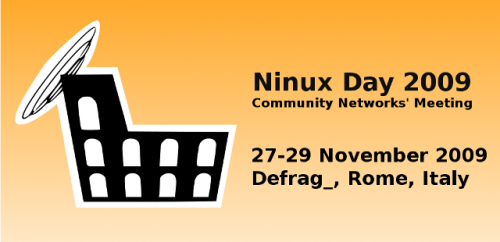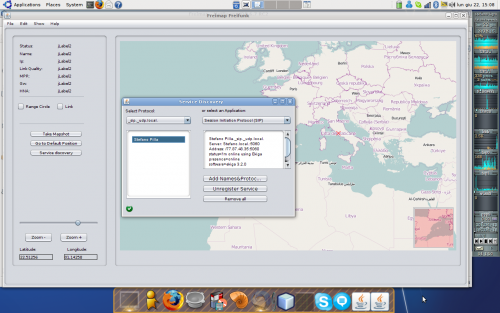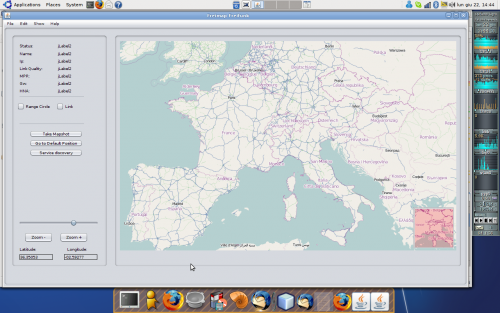Tag: ninux
Freifunk.net and Ninux.org accepted as Google Summer of Code Mentor Organizations
Freifunk.net and Ninux.org have been accepted as mentor organizations for the Google Summer of Code 2012. It is fantastic news that the growing international free networks community is now represented by two organizations in the study program.
If you are looking for more information on how to participate get in touch with your local wireless community or introduce your ideas on the wiki or Wlanware mailing list. People on the list will direct you to specific subprojects and contact points if needed.
Freifunk.net is an umbrella organization for wlan networks and community projects around the world and welcomes student applications for software tools to build and enhance free networks including:
* projects for routing protocols like OLSR, B.A.T.M.A.N. or other freely licensed protocols
* firmwares for routers and software for network devices
* software for network specific content creation like network CMS’
* any other network related software project
If you are a student there are important links to follow:
* Idea Page: http://wiki.freifunk.net/Ideas
* Student Check List: http://wiki.freifunk.net/Student_Check_List
* Mailing List http://freifunk.net/mailman/listinfo/wlanware
* Freifunk GSoC Page http://www.google-melange.com/gsoc/org/show/google/gsoc2012/freifunk
* Google Open Source Programs: http://socghop.appspot.com
There is an info day on March 15 in Rome. You can also meet many contributors to the community at the battle of the mesh in Athens from March 26-April 1: http://battlemesh.org/BattleMeshV5
Wireless Battle of the Mesh V3 – June 2-6, 2010 in Bracciano, Italy
The next ‘Wireless Battle of the Mesh’ will take place from Wed 2nd till Sun 6th of June in Bracciano (near Rome), Italy. The event aims to bring together people from across Europe to test the performance of different routing protocols for ad-hoc networks, like Babel, B.A.T.M.A.N., and OLSR. This third WBM will be improving the testbed conditions for mesh protocols with standardized testing procedures that will be reported after the event for the wireless communities.
On the development side, a flashing tool will be presented to simplify the deployment of such wireless networks based on OpenWrt stable release and packages for each protocol.
If you are a mesh networking enthusiast, community networking activist, or have an interest in mesh networks you have to check this out!
The Wireless Battle of the Mesh is an event that
aims at bringing together people from across Europe to test the
performance of different routing protocols for ad-hoc networks, like Babel, B.A.T.M.A.N., OLSR, and Static Routing. It
is a tournament with a social character. If you are a mesh networking
enthusiast, community networking activist, or have an interest in mesh
networks you might want to check this out! The goal of the WirelessBattleMesh
events is to set-up hands-on testbed for each available mesh routing
protocol with a standard test procedure for the different mesh
networks. During the different WBM events, similar hardware and
software configuration will be used based on the OpenWRT BoardSupportPackage
and packages for each protocol implementation. The WBM events are also
a great opportunity to develop testing tools for PHY/MAC radio layers
(drivers, scripts and PHY analyzers).
Location
========
The event will take place in the camping Porticciolo in Bracciano, Italy. along the border of the lake of Bracciano, just North-West of Rome.
Registration
============
Registrations will be available at different hackerspaces (Fusolab, HSBXL, /tmp/lab, metalab, CCC, …) and on the official website for the event at http://battlemesh.org
Fees
====
Every participant needs to donate 50 EUR (this should cover the costs for the camping, and the infrastructure). To finance this event, we ask you to pay when subscribing (paypal, bank transfer or cash).
Contact
=======
* Web: http://battlemesh.org/
* Email: contatti@ninux.org
* IRC: irc.freenode.net
#battlemesh
NinuxDay in Rome from November 27-29, 2009

The Ninux.org team announced the first “Ninux Day”, a weekend with about and for wireless communities. You will meet software and hardware hackers, geeks, nerds, engineers, artists, the curious and
academics. Experts from all over Europe offer technical and social presentations in the area of wireless community networks.
Join the Ninux Days in Rome, Italy, from November 27-29, 2009.

More Info here:
* http://wiki.ninux.org/NinuxDay2009
* http://wiki.ninux.org/NinuxDay2009en (English)
* http://wiki.ninux.org/NinuxDay2009it (Italian)
* Announcement: http://blog.ninux.org/2009/09/03/ninux-day-2009
* Ninux Blog http://blog.ninux.org
[via ZioPRoTo]
Multicast for OLSR mesh networks: Obamp release by Saverio Proto

Saverio Proto (ZioPRoTo) has the released the olsr OBAMP plugin, that was a freifunk project for the Google Summer Of Code. The OBAMP plugin allows multicast traffic to be forwarded in a OLSR mesh network. OBAMP is an overlay protocol. It first makes a mesh network with overlay links (udp tunnels) between the OBAMP nodes, and then it creates a distribution spanning tree over these mesh links.
This version of the OBAMP protocol, implemented as an OLSR plugin, is a simplified one for Wireless Community Networks, where we assume the nodes to be in fixed positions on the roof of the houses. Protocol features regarding mobility have not been implemented (yet).
To explain how the plugin works consider the scenario in the following figure:

There are 7 routers, where only 5 have the OBAMP plugin working. Router 1 2 and 6 also have an attached HNA network with some hosts.
OBAMP nodes generate OLSR OBAMP_ALIVE messages, these OLSR messages are forwarded in the whole network (also by the nodes that do not understand OBAMP thanks to the OLSR design). Because of the flooding mechanism every OBAMP node has a complete list of all the other OBAMP nodes in the mesh network. Every OBAMP node listens on the UDP port 6226 for OBAMP signalling.
When a OBAMP nodes starts it has 5 timers to periodically start operations:
OBAMP_alive_timer: every obamp node sends alive messages to advertise its presence to the other obamp nodes in the network. In the alive message every nodes states its IP address, and if it has already a tree link or not (we will see later this information is important for the outer tree create procedure).
The OBAMP network must have a member called “Core”, that starts the TREE_CREATE procedure. The core is the node with the smallest IP address. When the list of known OBAMP nodes changes, the Core Election procedure is eventually called.
mesh_create_timer: every obamp node every OBAMP_MESH_CREATE_IVAL evaluates how far the other obamp nodes are and selects a subset of nodes to keep mesh links with. Note that to reduce signalling and to increase scalability, the overylay mesh links are setup only with a subset of the nearest OBAMP nodes. To select the overlay neighbor the OBAMP nodes first calculates the ETX distance of the nearest OBAMP nodes, and the creates overlay mesh links to every node that are far in the range (minETX,minETX+1)
tree_create_timer: the core of the network every OBAMP_TREE_CREATE_IVAL sends a message called TREE_CREATE on its mesh links. The creation of the spanning tree is very similar to the spanning tree protocol. When a TREE_CREATE message is received a OBAMP node enables a tree link with its parent and forwards the TREE_CREATE on the other mesh links. TREE_CREATE messages are generated only by the core and are numbered, so TREE_CREATE received over loops can be discarded.
outer_tree_create_timer: The mesh_create algorithm may create cluster of OBAMP nodes within the network that are disconnected between each other. This happens if there are groups OBAMP nodes that are far from each other. If this happens only the cluster where the Core is present will receive the TREE_CREATE and will receive traffic from the distribution tree. To overcome this problem if in a cluster there are not TREE_CREATE every OBAMP_TREE_CREATE_IVAL the node with the smallest IP in the cluster will make a long mesh link with the nearest node that has at least a tree link. All the necessary information to perform this procedure is diffused in the OBAMP_ALIVE messages.
purge_nodes_timer: checks expire time of various variables, and deletes nodes or tree links in a soft state fashion
The OBAMP nodes will capture the multicast udp traffic from the non-OLSR interfaces, and will forward this traffic encapsulated in the UDP tunnels of the distribution tree. The other OBAMP nodes will forward the traffic in the tree and will decapsulate it on their non-OLSR interfaces. To avoid duplicated packets the data is carried into OBAMP_DATA messages, that are identified by a sequence number, and the OBAMP source node where the traffic has been encapsulated.
In the figure black links represent real radio links, and red links represent overlay mesh links (udp tunnels). Router 1 2 3 and will create a OBAMP cluster, with two mesh links. Router 6 and 7 will create a mesh link between them. Because the mesh_create algorithm does not create a mesh link between the two clusters, the router 6 (supposing it has the smallest IP address in the mesh) will create an outer tree link with Router 3.
So please download the code and use it . If you find bugs please report them to Saverio and in the Sourceforge tracker here:
http://sourceforge.net/tracker/?atid=681702&group_id=117612&func=browse
Thanks for this great result of the summer. Special thanks also to Nino from ninux.org who was the mentor for this projet.
Links
* http://zioproto.ninux.org/wordpress/2009/08/31/olsrd-obamp-plugin/
* http://gredler.at/hg/olsrd/rev/8e7887c1247f
* http://olsr.org
* http://blog.freifunk.net
* http://ninux.org
Wireless Freifunk Community Weekend Video Highlights from 2008
Another great series of interviews I filmed with Saverio from Ninux.org during the Wireless Community Weekend. Interviews with core contributors to the global Freifunk community:
* Kloschi from Leipzig about the future of Freifunk
* Bruno about the Horst tool developer
* Elektra from Berlin about the B.A.T.M.A.N. routing protocol and the goals of the developers.
Wireless Community Weekend 2008 Highlights from Saverio Proto on Vimeo.
Links:
* http://ninux.org
* http://leipzig.freifunk.net
* http://subsignal.org
* http://open-mesh.org
* http://perspektiv89.com
* http://wiki.freifunk.net/Wireless_Community_Weekend_2008
Freifunk & Ninux Video – Coproduction from the Archives
I just found an interview that I filmed during the Wireless Community Weekend 2008 online. The interview was done by Saverio from Ninux.org with Kloschi and Tetzlav from Leipzig and gives us a few insights where Freifunk is heading. Enjoy!
Wireless Community Weekend 2008: Interview with kloschi at C-Base Berlin from Saverio Proto on Vimeo.
Status of Service Discovery for Freimap development

An update on one of our Google summer of code projects: Service Discovery for Freimap. Stefano Pilla from Ninux.org is working on the project. We have widened the project a bit. He is now also working on porting freimap to IDE like
Netbeans. This will make it easier in the future to implement new graphic map views.
Service Discovery works fine and at the moment Stefano is testing a prototype and working already on documentation. During the project he got in touch with the creator of JmDNS, Rick Blair. JmDNS is an implementation of mdns for Java. He also started an exchange with the creator of JXMapKit
(SwingLabs – Josh) that is the new kind of map for freimap that we want
to use with Openstreetmap.
 screenshot of the "new freimap"
screenshot of the "new freimap"
An important mentor for this project is Alx Morlang from Freifunk in Berlin. Thank you! And our friends from Ninux namely – Saverio, Claudio and all of the team. Service Discovery will be tested first in the freifunk ninux network in Rome during the upcoming weeks with mdns.
 screenshot of the "new freimap"
screenshot of the "new freimap"
Interview with Free Wireless Evangelists from the Italian Ninux Community and the Freifunk Community in Germany
Saverio from the Italian Ninux community has now published a video interview Daniel Paufler and I conducted with them at the Wireless Community Weekend in Berlin. Thank you very much for the great montaggio! It is real fun to watch!
Interview to Ninux and Freifunk members at WCW2008 from Saverio Proto on Vimeo.
Direct Link: http://www.vimeo.com/1052320
In Berlin, at C-Base, people from wireless communities all around
Europe meet to share ideas and experiences. See this interview by Mario
Behling with free networks activists from Ninux.org and Freifunk.net
Freifunk Wireless Community Weekend 2008 – Thank you!
The Freifunk Wireless Community Weekend 2008 is over. I had a fantastic time meeting so many people pushing the idea of free networks to new hights. The interest in free wireless was overwhelming and we probably had more than double the number of the 51 visitors who put their names on the participants list. Many developers were taking part. We saw presentations about OpenWRT, B.A.T.M.A.N., the HorstTool, mikroFM, OpenHardware and the Luci-Interface for Freifunk networks. Receiving questions about "free networks and the implications of the law" regularly, we were extremely pleased that Reto Mantz recently published a doctoral thesis about this subject and held a presentation at the WCW (slides now available).
Besides German communities we were very happy to meet many friends from other countries like www.guifi.net from Catalunia, Spain, Sergey Yugov from Russia, Jesper Svarre with 28 people from Denmark and our friends from the Rome community ninux.org.
Together with the help of Italian and German Freifunkers Saverio and me made tons of interviews. Be sure it will not take two years this time to see them online 😉 Get a little taste of the WCW2008 with the first of a series of videos already published by our Italian friends.
Per ora vi lascio con questo breve video, che mostra qualche immagine
della domenicale del Wireless Community Weekend. Molto presto verranno
pubblicate le interviste. (http://blog.ninux.org/2008/05/05/lultima-sera-al-wcw2008/)
Direct Link: http://www.youtube.com/watch?v=gGZcH49j4hw
